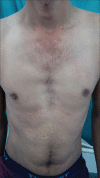A Case of Peeling Skin Syndrome
- PMID: 28584761
- PMCID: PMC5447344
- DOI: 10.4103/idoj.IDOJ_118_16
A Case of Peeling Skin Syndrome
Abstract
Peeling skin syndrome is a very rare autosomal recessive disease characterized by widespread painless peeling of the skin in superficial sheets. Etiology is still unknown with an autosomal recessive inheritance. Less than 100 cases have been reported in the medical literature. We present a 32-year-old man having asymptomatic peeling of skin since birth. Sheets of skin were peeling from his neck, trunk, and extremities, following friction or rubbing especially if pre-soaked in water but sparing palm and soles. Histologically, there was epidermal separation at the level of stratum corneum, just above the stratum granulosum. This case is being presented due to its rarity.
Keywords: Generalised non inflammatory; keratolytic; peeling skin syndrome.
Conflict of interest statement
There are no conflicts of interest.
Figures




References
-
- Sparker MK. Differential diagnosis of neonatal erythroderma. In: Harper J, Oranje A, Prose N, editors. Textbook of pediatric dermatology. Oxford: Blackwell Science; 2000. pp. 92–103.
-
- Sárdy M, Fáy A, Kárpáti S, Horváth A. Comel–Netherton syndrome and peeling skin syndrome type B: Overlapping syndrome or one entity? Int J Dermatol. 2002;41:264–8. - PubMed
-
- Levy SB, Goldsmith LA. The peeling skin syndrome. J Am Acad Dermatol. 1982;7:606–13. - PubMed
Publication types
LinkOut - more resources
Full Text Sources
Other Literature Sources

